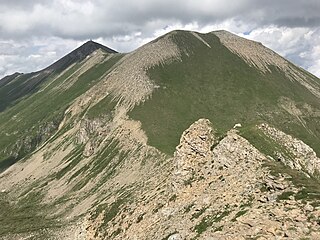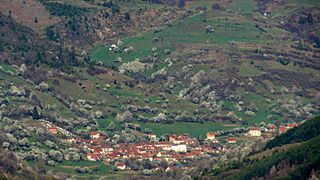
Vranje is a city in Southern Serbia and the administrative center of the Pčinja District. The municipality of Vranje has a population of 74,381 and its urban area has 55,214 inhabitants.

Sokobanja is a spa town and municipality located in the Zaječar District of the eastern Serbia. As of 2022, the population of the town is 7,188, while population of the municipality is 13,199.

The Šar Mountains or Sharr Mountains is a mountain range extending from southern Kosovo, to northwestern North Macedonia, to northeastern Albania. The sections in Kosovo, and in North Macedonia are national parks. Rugged and barren, the mountains are among the highest in the Balkans, with 30 peaks higher than 2,500 m (8,202 ft).

Štrpce or Shtërpcë is a town and municipality located in the Ferizaj District in Kosovo. As of 2015, it has an estimated population of 13,630 inhabitants.

The Lepenac is a river in southern Kosovo and northern North Macedonia, a 75 km (47 mi) long left tributary to the Vardar river.
Black Peak** is a peak of the Šar Mountains located in Kosovo and North Macedonia. Black Peak stands at 2,536 m above sea level. The famous Brezovica ski resort is situated close to the peak.

Eparchy of Raška and Prizren is one of the oldest eparchies of the Serbian Orthodox Church, featuring the seat of the Serbian Orthodox Church, the Serbian Patriarchal Monastery of Peć, as well as Serbian Orthodox Monastery of Visoki Dečani, which together are part of the UNESCO World Heritage sites of Serbia. More than 100 of the Eparchy's churches and monasteries were targeted for vandalism and destruction by Albanian nationalists after the Kosovo War and during the 2004 unrest in Kosovo.
Tourism in Kosovo is characterized by archaeological heritage from Illyrian, Dardanian, Roman, Byzantine, Serbian and Ottoman times, traditional Albanian and Serbian cuisine, architecture, religious heritage, traditions, and natural landscapes. Kosovo is situated in south-eastern Europe. With its central position in the Balkans, it serves as a link in the connection between central and south Europe, the Adriatic Sea, and Black Sea.

Gotovuša is a settlement in the Štrpce municipality in Kosovo. It is inhabited by ethnic Serbs, according to the 1991 census, it had 986 inhabitants. The village houses two churches, protected by the Republic of Kosovo.
Berevce is a settlement in the Štrpce municipality in Kosovo. It is inhabited by ethnic Serbs, according to the 1991 census, it had 792 inhabitants.
Viča is a settlement in the Štrpce municipality in Kosovo. It is inhabited by ethnic Serbs and Albanians, according to the 1991 census, it had 452 inhabitants.
Sevce is a settlement in the Štrpce municipality in Kosovo. It is inhabited by ethnic Serbs, according to the 1991 census, it had 1,283 inhabitants.

Sirinić or Syrinika is a term used for a historical region that covers 247 km2 (95 sq mi), including all of the Štrpce municipality in Kosovo, the borders of which it mostly overlaps. In the past it functioned as the Sirinićka Župa of Medieval Serbia. The region is inhabited mostly by ethnic Serbs, who, as a result of isolation, have maintained archaic folk customs, folklore and language.
Dvorane is a village in the Suva Reka municipality in the disputed region of Kosovo. It has an ethnic Serbian majority; according to the 1991 census, it had 510 inhabitants. According to tradition, the village name is derived from dvorovi, because there were many in the village during the time of Emperor Dušan.

The forests of Kosovo make up about 44.7% Agricultural land comprises 53% of Kosovo's total land area and forests 44.7% of the entire surface of the territory. Most of the forests are located in southwestern Kosovo, including the outskirts of Peja, Deçan, Istog, Junik and Gjakova and are protected by particular laws of the Kosovar Constitution. There are several types of forests in Kosovo and they are mostly represented by pinnate ones.

Monastery of the Mother of God in Hvosno was a Serbian Christian monastery of the Serbian Orthodox Church in the historical region of Hvosno. It was situated at the foot of Mokra Mountain, nearby hamlets Vrelo and Studenica, some 20 kilometers (12 mi) north of the city of Peć, in modern Kosovo. The Monastery was declared Monument of Culture of Exceptional Importance on 10 July 1967, and Republic of Serbia claims to have it under protection.
The municipality of Štrpce consists of 16 villages: Berevce, Brezovica, Brod, Vica, Vrbestica, Gornja Bitinja, Gotovusa, Donja Bitinja, Drajkovce, Izance, Jazince, Kostanjevo, Firaja, Sevce, and Strpce. There are 16 churches and 3 mosques located in Štrpce. There are also several war memorials which represent the cultural and historical values of Štrpce.

The Church of St. Nicholas (Serbian: Црква светог Николе/Crkva svetog Nikole; Albanian: Kisha e Shën Kollit is a Serbian Orthodox church built in the mid-16th century, located in Štrpce, Kosovo. It lies by the village graveyard.

Brezovica ski resort or Brezovica ski center, is a mountain resort and the largest center of winter tourism in Kosovo. Located on the slopes of Šar Mountains, it is mainly a destination for skiing and snowboarding. In the summer, eco-tourism opportunities include hiking, mountain biking, golf, and other outdoor recreational activities. Hiking paths can lead the visitors to the nearby Livadh Lake.
The Church of the Holy Archangels is a former 14th-century Serbian Orthodox church in Gornje Nerodimlje near the city of Uroševac, Kosovo. It is listed as a Cultural Monument of Exceptional Importance of the Republic of Serbia. It was destroyed by Albanians during the Kosovo War.














